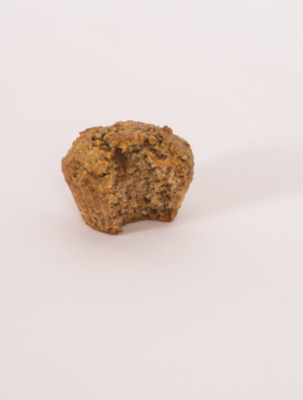
“No Sugar-Added” Breakfast Muffins
By Kelsie Knerr
Ingredients
- 2 medium carrots, ground or grated
- ½ medium zucchini, ground or grated
- 3 pitted dates
- 3 eggs
- ½ cup unsweetened applesauce
- 1 cup all-purpose flour
- 1 cup almond meal
- 1 ½ teaspoons baking soda
- ¼ teaspoon salt
- 1 teaspoon cinnamon
- 1/3 cup hemp hearts (or ground chia seeds)
What are hemp seeds?
Hemp and marijuana are members of the same plant species, but hemp seeds won’t make you fail a drug test! They’re also called hemp nut, hemp hearts, or shelled hemp seed – the outer hard shell is removed, leaving the nutty-tasting “heart.” Hemp seeds resemble coarse bread crumbs and can be added to pretty much anything – oatmeal, salads, smoothies, sauces – or made into milk or flour. Hemp seeds contain omega-3s and omega-6s, which are essential fatty acids, and are a great source of plant-based protein and valuable vitamins and minerals, like vitamin E, magnesium, potassium and iron.
Instructions
- Preheat oven to 350°F and prepare muffin tins.
- In a food processor, blend carrots and zucchini until fine, then squeeze out excess moisture – a kitchen towel or potato ricer works well for this.
- In a food processor, blend dates, eggs, and applesauce and add to the bowl with your vegetables.
- Add dry ingredients and mix together.
- Add to prepared muffin tins (I like the reusable silicone liners) and bake 20-25 minutes.
Nutrition
188cal
9g fat
0.5g sat fat
4g polyunsaturated fat
4.5g monounsaturated fat
20g carbohydrates
4g dietary fiber
7g sugar (no added sugar)
7g protein
252mg sodium
187mg potassium
51mg cholesterol
41% vitamin A
11% vitamin C
8% calcium
8% iron
I am a dietitian and a baker. It may surprise you to know that, when I bake, I love making the classic, full-butter, full-sugar recipes most of the time. When I want something satisfying, going half-way usually doesn’t hit the spot. Part of the satisfaction comes from my memories of baking with Grandma or enjoying a special recipe as a kid. The other part comes from the mouthfeel of the butter, the fluffiness of the refined white flour, and the sweetness of added sugar.
Even as a health professional, I believe there’s still a place in life for decadently rich and sweet versions of our favorite foods. But there are small ways you can think like a dietitian and bake like a Grandma.
Baking for yourself, instead of purchasing premade desserts, gives you more potential to make healthy decisions. Baking gives you the say on serving sizes and due to the effort involved in preparation, you may not have them as frequently. You can control portions by making smaller servings using a mini cake or muffin pan; freezing half a batch of cookie dough to bake later and sharing baked treats with friends.
And it’s good to be open to trying new things. After trying this muffin recipe – and really enjoying it – I’m more open-minded about baking substitutions, like using fruits and veggies for sweetness or nuts and seeds as healthier fat options.
I originally tried this recipe to help my 1-year-old daughter eat more protein and healthy fat in a form that I already know she loves – anything sweet that resembles bread!
It’s been fun to watch her taste preferences change from day to day and see her discover foods like these muffins, which she scarfs down and loves. I have yet to see her touch the scrambled eggs I offer, but have found she will happily eat eggs baked with veggies in a casserole dish or cooked in a waffle iron.
Taste buds are adaptable, especially early in life, and one of my personal missions is to expose my daughter to a wide variety of foods and preparation techniques. I may present boiled eggs one day and scrambled the next, and of course, I make sure she’s offered foods from a variety of food groups. Continual exposure is important to help children (and adults) accept new foods.
When my daughter munches on one of these muffins at breakfast, I know she’s consuming healthy fats, high-fiber carbohydrates, protein, and so many vitamins and minerals that a typical muffin wouldn’t have. I don’t need the big scoop of sugar most muffin recipes call for, because the fruits and veggies make these muffins naturally sweet.
Fat:
Typical breakfast meals contain mostly carbs, like cereal, or saturated fat, like bacon or buttery biscuits. 40% of the fuel from these muffins is heart-healthy unsaturated fats, which give you long-lasting energy to get through the morning. The 2015 Dietary Guidelines for Americans recommend children 1 to 3 years old get 30 to 40% of their total calories from fat, so I feel good knowing my daughter’s getting the nutrition her brain needs for development.
Protein:
This recipe uses 1 cup of almond meal, which has double the protein and quadruple the fiber compared to 1 cup of regular all-purpose flour. Together, the eggs, almonds, and chia/hemp seeds give each muffin 7g of protein.
Fiber:
In this recipe, the carrots and zucchini provide these muffins with filling fiber – do yourself a favor and don’t peel your veggies for even more fiber. Each muffin provides 4g of fiber, which encourages regularity and lasting fullness.
I hope this recipe empowers you to start adapting your favorite recipes with more nutrient-dense ingredients to improve your typical meal routine. And keep switching up how you prepare foods you want your family to learn to enjoy. Live a little more on the veg!